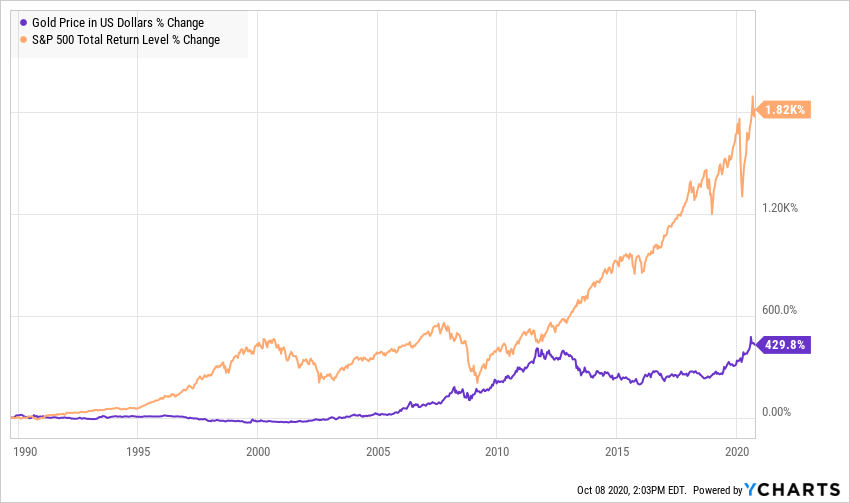My political party is best for the stock market
False: Markets don’t care who is in power.
The United States presidential election is due to be held on Tuesday, 3 November. One of the media’s favourite pastimes is speculating on its potential impact on the stock market. But the data is unequivocal, markets rise regardless of who is in power.
Buying or selling because your preferred candidate loses or wins the election is fatal to long-term market returns. To illustrate this point, the graph below shows the derisory returns you would have earned on the Dow Jones Industrial Average had you only invested when a Democrat or Republican was in office. Partisan portfolios have underperformed a fully invested portfolio by millions of dollars.

The lesson from this is to not allow your political views to influence your investment decisions. Should investors not heed this, they will encounter another big problem, which is that the impact of one political party or election on the market isn’t what you’d always expect. For example it was widely believed that the US markets would slump if Donald Trump became president in the 2016 US election, of course the opposite occurred. At the time, US hedge fund Bridgewater associates expected a 10.4% drop in US equities if trump won the 2016 election. It didn’t happen and the following day the S&P 500 rallied 1.1%.
Markets have no political allegiances, they are driven by future earnings and these are affected by a multitude of factors beyond the parties’ control.
All-time highs are ominous signs of an upcoming downturn
False: Stock markets always hit all-time highs, this is normal
Don’t let all-time highs deter you from investing in the stock market. All-time highs are a natural feature of the market which has increased 3 out of 4 years. The stock market hits all-time highs about once every 20 days, this is a normalcy.
According to Ben Carlson, director of Institutional asset management at Ritholtz Wealth Management, the average market returns following all-time highs (since 1950, US stocks) are 10%, 31% and 54% over one, three and five years respectively.
If you believe markets are overvalued and are thinking about going into cash, remember this: a hypothetical $500,000 invested in the S&P 500 on 1988 would be worth £10,290,805 by 03/31/2020 had you remained fully invested. Missing just the 10 best days would mean your portfolio being worth just $5,046,218, a reduction of 50%.

Gold is a safe-haven asset with attractive long-term returns
False: Since the great depression, gold has underperformed bonds and equities whilst producing higher volatility.
But that doesn’t stop various pundits and the financial press from promoting this barbarous relic as an essential safe haven asset.
Low returns
Since it became legal for US citizens to own gold on Dec 31, 1974, gold has delivered an annualized return of 5.3%, over the same period the S&P 500 has earned a 12% annualized return. A hypothetical $10,000 investment in gold would have grown to $105,000 over that period, where as in the S&P 500 it would have reached $1.75 million.
Below is a graph from YChart displaying the gold price in dollars vs. the S&P 500 total return since September 1989 to 08/10/2020. The year 1989 was the furthest YCharts records would allow for the total returns of the S&P 500, nevertheless it is a clear illustration of the superiority of equities over gold.

Not an inflation hedge
The evidence of Gold as an inflation hedge is mixed at best. During the inflationary 70’s it delivered double digit returns, whereas during the high inflation of the early 80’s it posted negative returns.
US inflation reached 13.5% in 1980, 10.3% in 1981 and 6.1% in 1982 — During this period gold fell by more than 30%; this is not how an inflation hedge and safe haven asset should perform.
Too volatile
As for volatility, gold seems to break the pattern of more risk for higher returns. If we look at the risk vs. return for various asset classes, gold’s unappealing characteristics become clear. It produces much higher volatility in exchange for lower returns.

My view on gold is eloquently summed up by a quote from Adrian Frost, a British fund manager who stated that: “Gold is a club of collective terror where the people who hold it spread doom and gloom — and then invite you to buy the store of value that they own at a higher price than they have paid. It is an elaborate and enduring spoof, but one that has infinitely attractive characteristics.”
Summary
The markets rise whoever is in power
Market hitting new all-time highs is normal and shouldn’t be construed as a bearish indicator
Gold is a bad investment — its more volatile, has lower returns and is a poor inflation hedge.
